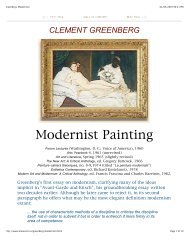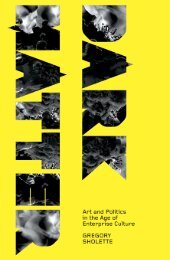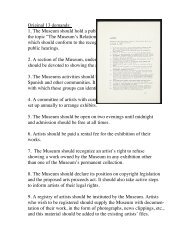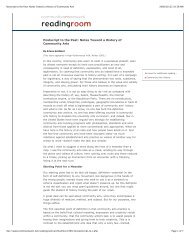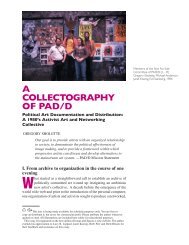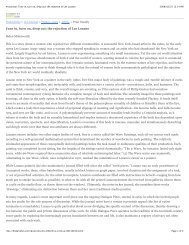Screen - Dark Matter Archives
Screen - Dark Matter Archives
Screen - Dark Matter Archives
Create successful ePaper yourself
Turn your PDF publications into a flip-book with our unique Google optimized e-Paper software.
34a travesty of the norma l canons of 'Seallty', obvjously. and anattempt to make the nude, of all unlikely genres, exemplify theorders of social class. The Bather was meant to be read as abourgeoise, not a nude: she was intended to register as the unclothedopposite and opponent of male proletarian nakedness; andso Courbet displayed the painting in the Salon alongside anotherof roughly equal size, in which a pair of gnarled and exhaustedprofessional wrestlers went through thejr paces in the Hippodromedes Champs-ElySl!es.But The Bather broke the rules of the nude in other ways, whichwere hardly more subtle. hut perhaps more effective. It seemed tobe searching for ways to establish rhe nude in opposition to rhespectator, in active refusal of his sight. It did so grossly, clumsily,but not without some measure of success, so tbat the critic at thetime who called the woman 'this heap of matter, powerfully rendered,who turns her back with cynid sm on the spectator' had gotthe matter right. The pose and the scale and the movement of thefigure end up being a positive aggression, a resistance to visionin normal terms.There is no doubt that for Manet and his critics in 1865 theseprecedents were inescapabJe: as I have said already, the critleSwanted Ma·net to be a ReaBst in Courbet's terms, But Olympia , Iwo uld argue, takes up neither the arrangements by which thecanonical images of the nude establish access, nor Realism's knockaboutrefutations. What it contrives is stalemate, a kind of baulkedinvita tion, in which the spectator is given no estabHshed place forviewing and identification, nor offered the tokens of exclusion andresistance. This is done most potently, I suppose, by the woman'sgaze - the jet-black pupils, the slight asymmetry of the lids, thesmudged and broken corner of the mouth, the features halfadheringto the pla in ova l of the face. It is a gaze which givesno th ing away, as the reader attempts to interpret its blatancy : alook direct and yet guarded, poised very precisely between addressand resistance. So precisely, so deHberately, that it comes to beread as a production of the depicted person herself; there is aninevitable elision between the quaHties of preciSion and contri vance in the image and those quaHties as inhedng in the fictivesubject; it is her look, her action on us, her composure, her compositionof herself. But the gaze wou ld not function as it does- as the focus of other uncertainties - were it not aided andabetted by the picture's whole compOsition. Pre-eminent1y, if it isacccess that is in question, there is the strange indeterminate scaleof the image, neither in timate nor monumental: and there is thedisposition of the unclothed body in relation to the spectator'simaginary position: she is put at a certain , deliberate markedheight, on the two great mattresses and the flounced-up piJIows:in terms of the tradition, she is at a heigbt whicb is just too high,suggesting the stately, tbe body out of relation to the viewer'sbody; and yet not stately either, not looking down at us, nothieratic, not imperial: looking directly out and across, with asteadying, dead level interpellation. Tbe stalemate of 'placings' isimpeccable and typical, that is my point. If at this primary level_ the arrangemenr within the rectangle, so to speak, the laying. out in illusory depth - the spectator is offered neither access norexclusion, then the same applies, as I shall try to sbow, to thepicture's whole representation of the body.(b) Wbat the critics indicated by talk of 'incorrectness' in thedrawing of Olympia's body, and a wilder circuit of figures of dislocationand physical deformity, is, I would suggest, the way thebody is constructed in two inconsistent graphic modes. which onceagain are allowed to exist in too perfect and unresolved an equilibrium.One aspect of the drawing of Olympia's body is emphaticaUylinear: it was the aspect seized on by the critics, and given ametaphorical forc(>, in phrases like 'c ern~s de noir', ' dessin~e aucharbon', 'raies de drage' 'avec du charbon tout autour', 'Ie grosmatou noir . . air d~teint sur les contours de cette belle personne,apr~ s s'etre coule sur un ras de charbon'.ll (These arefigures which register also a reaction to Maner's elimination ofhalf-tones, and the abruptness of the shadows at the edges of hisforms: but this, of course, is an aspect of his drawing, taken inits widest sense.) The body is composed of smooth hard edges,deliberate intersections : the lines of the shou1ders, singular andsharp; the far nipp le breaking the contour of the arm with an artificial exactness; tbe edge of thigb and knee left flat and unmodulatedagainst the dark green and pink; the central hand markedout on a dark grey ground, 'impudiqument c ri sp~e' - in otherwords. as Pierrot implies. refusing to fade and elide with the sexbeneath, in the metaphoric way of Titian and Giorgione. Yet this isan incomplete account. 1he critics certainly conceived of Olympiaas toO definite - full of '!ignes heurtees qui brisent les ye ux'l~ but at the same time the image was accused of lacking definition.It was 'unfinished ', and drawing 'does not exist in it' ; it was'impossib le', elusive. 'informe'. Olympia was disarticulated, butshe was also inarticulate. I believe that this is a reaction on thecritics' part to other aspects of the drawing: the suppression ofdemarcations and definitions of parts: the indefinite contour ofOlympia's right breast, the faded bead of the nipple; the sliding,dislocated ]jne of the far fotearm as it crosses (tollches?) thebelly ; the elusive logic of the transition from breast to ribcage tostomach to hip to thigh. Tbere is a lack of atriculation here. It isnot unprecedented, this refusa1; and in a sense it tallies well with11 L de Laincel,C Echo deProvinces, 25 June1865, p 3.12 P Gill e, L' /nternational,1 June1865.35



